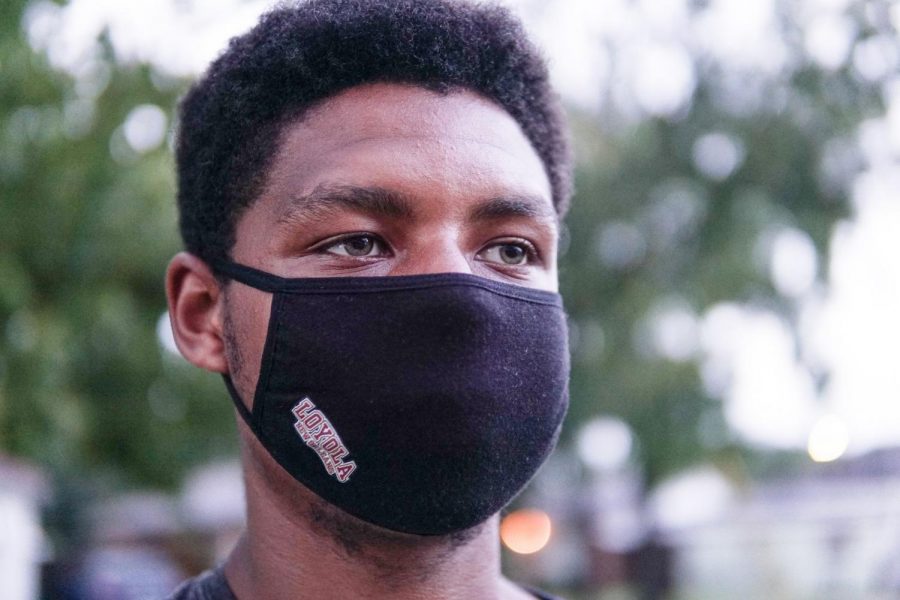Loyola-branded masks raise controversy about their effectiveness
Omari Caldwell poses while wearing his university-provided mask on Friday, Aug. 28. Although the masks do follow CDC guidelines, the effectiveness of the face coverings have recently come under scrutiny from students.
August 29, 2020
While wearing the Loyola-issued masks, you can blow out a candle. According to Bill Nye, this means that a mask is ineffective. But according to government agencies, the university and a biologist, there might be more to a mask than its candle-blowing power.
In the first video Bill Nye posted on TikTok about mask effectiveness, he used different face coverings such as a scarf, a homemade mask and later an N95 mask in the second video by attempting to blow a candle out with the mask on. He said that blowing a candle out was a sign of the mask’s effectiveness in blocking the movement of air.
Posts on social media and the test for mask effectiveness conducted by The Maroon staff have raised questions about whether the face coverings provided by Loyola are protective enough, although the university says the masks are effective.
Three members of The Maroon staff tried the test wearing the masks that Loyola issued to students as they moved onto campus this semester, with all members that tried successfully blowing out the candle. This means that the Loyola-issued mask does not block the movement of air enough to stop blowing a candle from out. So, by the Bill Nye candle test, the Loyola-issued masks fail.

However, this doesn’t mean that the Loyola-branded masks are unsafe.
Amy Price, a senior research scientist at Stanford University’s Anesthesia Informatics and Media Laboratory, told NPR in a recent article “that the test isn’t foolproof,” and to “take your results with a big, big grain of salt.”
Of course, no mask will protect you 100% from contracting COVID-19, Loyola biology professor Patricia Dorn said.
“It’s a matter of reducing the amount (of aerosols),” Dorn said. “We still want to stay six feet apart.”
Although the Loyola-issued masks were able to blow out a candle, it doesn’t necessarily mean that they allow water droplets to pass through the mask.
“Some people have likened that to like a mosquito going through a wire span. Well of course it will,” Dorn said. “But if you had a mosquito in a tennis ball, it wouldn’t get through.The virus is very small, but it is inside a droplet which is much larger.”
The Loyola-issued masks also follow Centers for Disease Control and Prevention guidelines for selecting an appropriate mask.
The masks are a gift from donors who contributed funds this summer to purchase 5,000 Loyola-branded masks for students, faculty and staff, Patricia Murret, associate director of public affairs said.
They are two-layers-thick and made of 95% cotton and 5% spandex with spandex loops, according to Murret.
“Their lightweight feel is one of the reasons they were selected—a mask mandate in our hot climate makes comfort and wearability all the more essential,” Murret said.
She also noted that the masks are the baseline for acceptable face masks that should be worn on campus.
“Two layer cotton masks have been shown to be quite effective,” Patricia Dorn said.
Currently, Loyola does not approve bandanas, gaiters or masks with valves or vents according to the Loyola FAQ page.
Although the Loyola-issued masks follow the CDC guidelines, the World Health Organization recommends that all fabric masks should be three layers thick.
In the mandatory COVID-19 and Emergency Preparedness training on Canvas, a video from WHO is played under the tab for wearing a mask.
“They should ideally be three layers,” Dr. April Baller said in the video. “The outer layer should be a water resistant fabric, the inner layer should be water absorbent and the middle layer acts as a filter.”
The Loyola-issued masks do not meet all of the WHO standards for wearing a fabric mask, but they do meet the CDC guidelines. Being that the Loyola-issued masks are only the baseline for wearing a mask on campus, nothing is stopping students from wearing one of their own that meets the WHO standards.
“Whether you choose to wear the Loyola-branded mask, or one of your own, you must wear a mask on while on campus,” Murret said.








